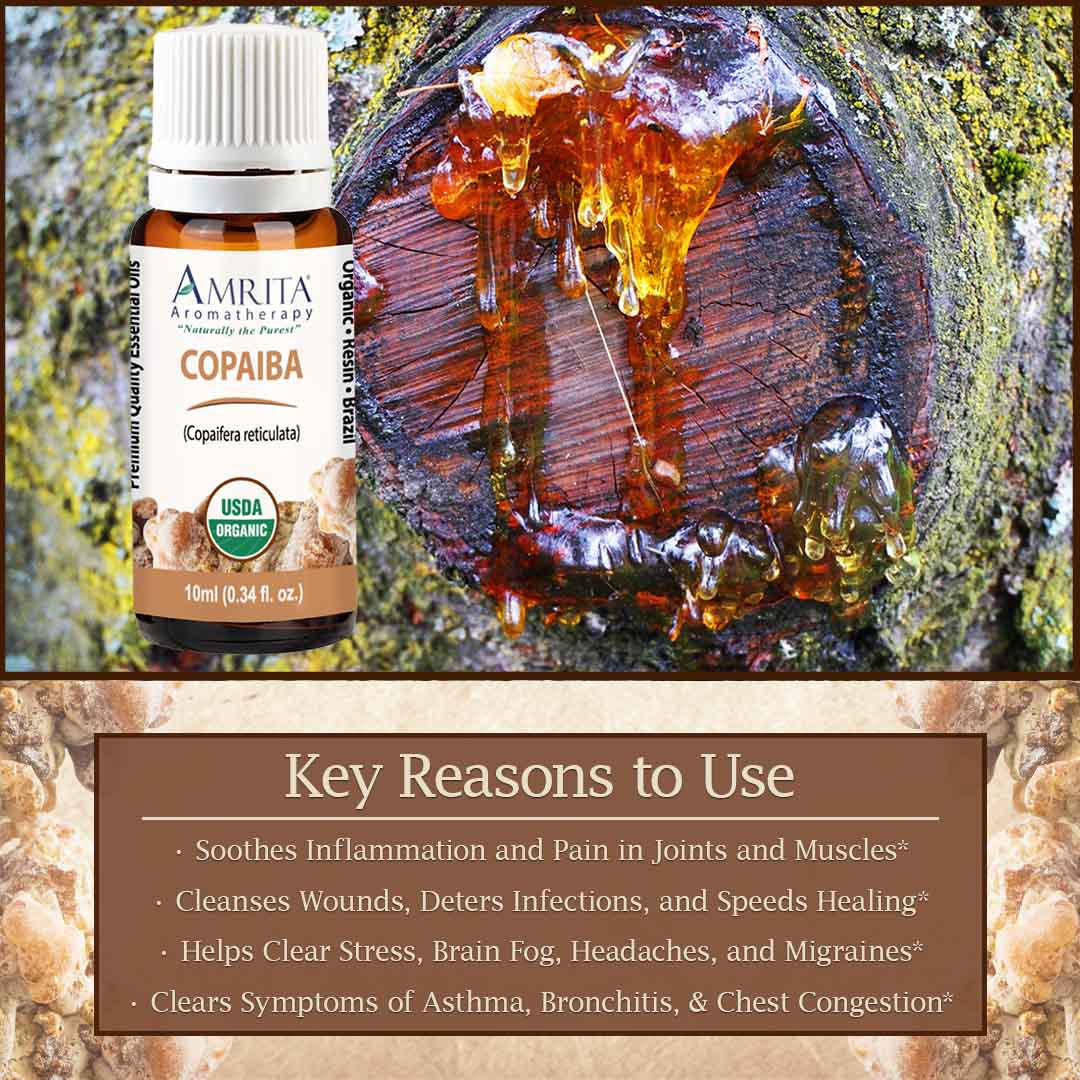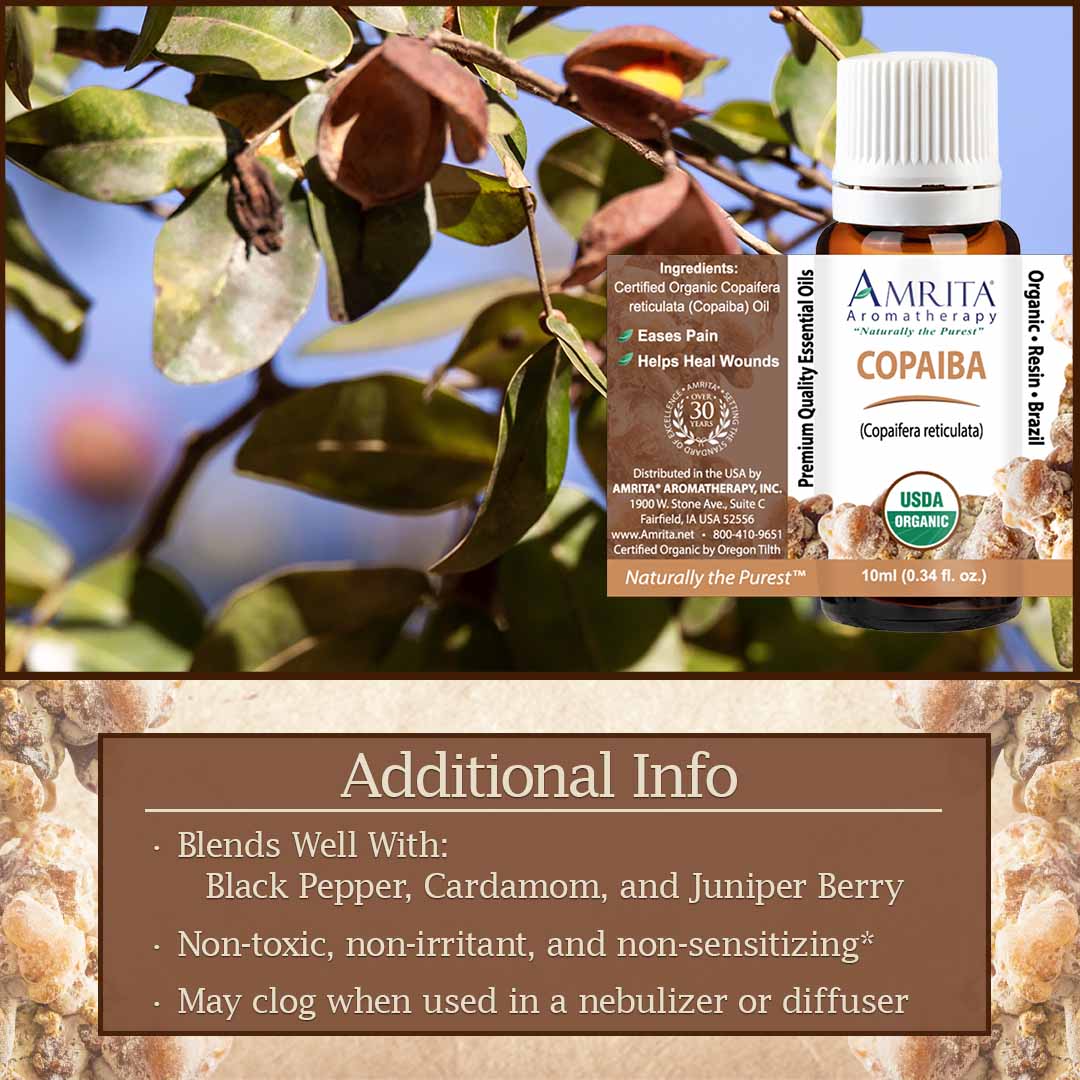Product Spotlight: Copaiba
Jun 4th 2024
Posted by Dr. Christoph Streicher and Chase F.
The Amazon Rainforest is known as the “medicine cabinet of the world” by many, and the reasoning behind that is simple. Over 25% of all pharmaceutical products are sourced from the Amazon, not to mention many others which are synthetically produced to mimic compounds found there.1 Surprisingly enough, this is despite the fact that only about 10% of the overall plant species of the Amazon have been studied and analyzed for potential medicinal value! These numbers suggest enormous implications for further development of therapeutically beneficial products to be discovered not only in the Amazon, but in rainforest regions throughout the world.
Of course, we all know the Amazon faces huge problems such as climate change, deforestation, and overexploitation, problems that have undermined its very existence for many decades. Large swaths of its acreage are burnt and eradicated to create commercial farmland and grazing areas for livestock in order to feed and fuel an ever-growing global economy. One can only wonder how many potential wonders disappear with each precious acre of rainforest that is decimated.
However, there do exist some shining examples of sustainable, therapeutically beneficial plant species, responsibly obtained from this magical region of the planet’s southern hemisphere. One prevalent example is the Copaiba tree, whose numbers have remained virtually unfazed over the years by the many threats to the Amazon… more specifically, a subspecies of Copaiba botanically titled Copaifera reticulata. Representing up to 70% of all Copaiba subspecies, Copaifera reticulata continues to thrive after millennia of use by indigenous and non-indigenous peoples alike. This is due in part to the fact that Copaiba’s therapeutic value lies in its resin, which can be extracted twice a year in large amounts without harming the overall plant.
This article will explore some of the past and present, as well as future of Copaiba, including the therapeutic value this precious plant can offer to all of humankind. So, let us now delve further into the wondrous nature of Copaiba. (Please be sure to check out the final section of this article for more thoughts on the origins of the Amazon rainforest and its implications for a sustainable future).
A Bit of Background About Copaiba

When a Portuguese Monk Manuel Tristaon wrote about his observations of Copaiba use by Brazil’s indigenous peoples in 1625, it had probably already been harvested for millennia for a number of applications. Practically, the oil extracted from the tree bi-annually had been used as an ingredient in varnishes and lacquers, as well as an additive for foods and beverages. But it was the resin’s therapeutic value that would become the main focus of scientific research over the following 400 years.
Brazilian natives had long recognized its abilities to combat respiratory issues, quell pain from a number of sources, eliminate fungus, and deter insects.* Their remedies were created by making teas and salves from the resin of the Copaiba tree, leaving the tree wholly intact to continue thriving and providing. Since then, modern scientific advancements have been made in the analysis and procurement of this magical resin. The advent of steam distillation has allowed Copaiba resin to be obtained in its purest possible form and its chemical composition to be scrutinized, all while leaving the tree unharmed, just as the indigenous peoples have done.
Interestingly enough, it was discovered that when the purest elements of the oil were obtained through steam-distillation, it could be used as a potent source of biodiesel fuel. The therapeutic value of Copaiba as a health supplement was confirmed upon analyzing the composition of its pure essential oil. Now that it's clear that Copaiba truly possessed anti-inflammatory, decongestant, and other therapeutic abilities, it can be embraced by the modern aromatherapy industry as one of the rare essential oils to be sourced from the Amazon rainforest.* Because of its unique biological makeup, Copaiba truly sets itself apart from essential oils found anyplace else.
Copaiba: An Alternative Among Alternatives
Natural compounds found in pure, steam distilled Copaiba resin, such as β-Caryophyllene, Germacrene, α-Humulene, α-Copaene, and α-Bergamotene, help to explain some of its therapeutic benefits. There are many essential oils that can aid the nervous system, musculoskeletal system, respiratory system, etc., but Copaiba Essential Oil shares these abilities, even as it has evolved its own unique chemical composition in an environment that would seem very alien to the geographical areas from which most other essential oils are sourced.* If aromatherapy exists within the realm of “alternative” medicine, then Copaiba with its rare, Amazonian genetics, exists as an outlier, even among a group that already resides outside of the conventional paradigm.
The point is this: No one person is alike, therefore universal solutions to any ailment are rare.* For example, a woman may try to mitigate menstrual discomfort with Mastic Essential Oil as many others have done with success, only to find that Copaiba delivers much more effective results.* Both Mastic and Copaiba have been held in high regard for possessing that specific ability, but each comes from completely different environments, evolving in unique ways over time with distinctive chemical compositions. This explains the importance of options for a worldwide population of people which is NOT “one-size-fits-all.” What works for one person may not work for another. For some, Copaiba may be an ideal remedy when other aromatherapy solutions simply don’t strike the right “chemistry” for their unique constitution.* So, let’s explore some of the therapeutic benefits offered by this Amazonian treasure…
Therapeutic Benefits of Copaiba
Copaiba Essential Oil is first and foremost renowned for its anti-inflammatory properties.* It demonstrates this ability so potently that even symptoms associated with chronic ailments like arthritis can be effectively mitigated.* It has even been shown to have neuroprotective properties in cases where its anti-inflammatory actions can reduce the damage caused by acute stroke.* Studies have shown that these benefits are even noticeable after only one application.* More common symptoms, such as sore muscles, weary joints, menstrual discomfort, headache, and migraine can also be directly targeted by the tropical wonder that is Copaiba.*
Additionally, Copaiba exhibits powerful benefits to the respiratory system.* Its expectorant actions help to clear the lung congestion and can help mitigate symptoms associated with bronchitis and asthma.* However, instead of the foul, chemical taste and/or odor of pharmaceutical products aimed at those same symptoms, Copaiba Essential Oil produces similar results with its pleasantly woodsy, sweet, balsamic, naturally balanced composition. This aromatic essence also delivers impressive results to the nervous system, enhancing the mood and calming the spirit to help provide users with more focus throughout the day and achieve better rest at night.*
Copaiba Essential Oil additionally demonstrates a wide range of benefits for body care. Its antiseptic, antibacterial, and antifungal actions help to gently clean wounds, reduce scarring, prevent athlete’s foot, and even mitigate acne while simultaneously providing a rosier, healthier complexion.* It has also been used traditionally by many to help deter insects, which for obvious reasons can protect the skin from potential harm.*
How to Use Copaiba Essential Oil
Copaiba is considered to be non-toxic, non-irritant, and non-sensitizing.* This leads to a wide range of application methods including topical, massage, and aromatic bath. Its woodsy, sweet, slightly peppery, balsamic aroma is much more pleasant than that of many conventional remedies derived from less natural ingredients. It is also one of the rare essential oils which can be taken orally, as long as it is 100% therapeutic grade, pure, and not adulterated.* However, it is not recommended to ingest large doses and should never be attempted without consulting a health care professional and/or aromatherapy expert.* It should also be noted that Copaiba Essential Oil is NOT recommended for use in diffusers, nebulizers, or inhalers due to the fact that the resin may clog such devices. The following is a breakdown of suggested application methods for Copaiba Essential Oil (excluding oral ingestion) and some of the targeted outcomes for each.*
- Targeted Topical Application: Make a dilution blend of up to 3-5% of Copaiba Essential Oil in any carrier oil (15-25 drops per tablespoon of carrier oil). Apply a small portion of this blend, do not exceed 10 drops per application per day, to affected areas. One suffering from stress, anxiety, brain fog, or poor sleep quality could try applying this mixture to the temples and/or forehead.* Areas of joint pain, muscle soreness, or menstrual cramps can be targeted in a similar way.* Apply a small portion of this dilution, do not exceed 10 drops per application per day, to the chest in order to provide lasting mitigation of respiratory congestion.* Also, specific areas with skin ailments such as acne, spotty complexion, or even minor superficial wounds stand to benefit from this application method as Copaiba has been known to safely clean the skin, prevent infection, regulate oil production, and enhance blood flow.*
- Whole Body Massage Application: A maximum of 2% dilution of Copaiba Essential Oil in any carrier oil (10 drops of Copaiba per tablespoon of carrier oil) can be utilized as a pleasant massage oil. It can provide many of the same benefits to the nervous system, musculoskeletal system, and skin as the overall topical application method mentioned above, but in a more widespread manner that is less targeted towards localized symptoms.* This method also helps to accentuate the pleasant aroma of Copaiba as it is applied to the entire body rather than specifically targeted areas.*
- Aromatic Bath Application: Aromatic Bath is perhaps one of the best application methods Copaiba to benefit the nervous system.* Its exotically pleasant scent can be enjoyed with a soothing bath by simply creating a 2% dilution of Copaiba Oil in bath salts, bath milk, or similar (no more than 10 drops of Copaiba per ounce of bath product) and adding to a full tub of warm bathwater. The comfort of the bath combines with the soothing essence of Copaiba to create a formidable force against stress and anxiety.* This method will also provide some similar benefits to the musculoskeletal system and to the skin as other topical methods, but again, not in the specifically targeted manner provided via direct topical application.*
Remember, even if you’ve already tried to alleviate similar symptoms with other essential oils and experienced disappointingly lackluster results, everybody is different. Copaiba, with its unique geographical origin and distinctive chemical composition, may just be the aromatherapy option for your specific body chemistry.* Copaiba is proof that nature offers humanity a plethora of remedies as diverse as humanity itself, and it could be a well-tailored solution to your individual needs.
Bringing it Back to the Amazon…
When most people picture the Amazon rainforest, they think of it as an enormously diverse, natural, God-given entity that only stands to be harmed by pollution, overharvesting, large-scale land clearing, and many other side effects of human misuse. But new scientific and historical revelations have hinted at a mind-blowing alternative for the traditional narrative. Modern research has revealed that the Amazon rainforest may have actually been… wait for it… DESIGNED BY HUMANS? Yes, you heard that right, humans. It is now believed by many that over the course of hundreds of years of trial and error, experimentation, and horticultural knowledge passed down from generation to generation, indigenous peoples of South America may have gradually and deliberately created the Amazon rainforest.1
The implications of such a breakthrough boil down to one simple thing: Hope.

As it becomes increasingly clear that modern practices must evolve to create sustainable means of providing for humanity without eradicating the very resources we depend on, many people have sought to create self-sustaining farms which require no unnatural fertilizers or pesticides and use only natural processes to continue permanently. Is it possible that this was already achieved long ago on a mind-bogglingly enormous scale by indigenous peoples of South America as they developed the Amazon rainforest? In short, yes. The same people who discovered Copaiba Oil, and how to harvest it sustainably and effectively, just might have been the ones who designed and created the Amazon rainforest itself.
If this is true, it means that it is in fact possible to create such a paradise on earth; one that uses only natural processes to grow and thrive. It also means that human beings are capable of creating it. As mentioned at the beginning of this article, the Amazon and other rainforests are now famously in peril due to the destructive practices of modern humanity. The Copaiba species is one of the few Amazon species that has effectively dodged these perils and is not currently at risk of endangerment, though many others have not met with such luck. But simply knowing that ancient peoples may have been able to construct the absolutely incredible, and more importantly, self-sustaining life-force that is the Amazon rainforest should inspire us to rediscover such knowledge and apply it to the sustainability of life on earth for the future of all humanity.
While Amrita Aromatherapy, an industry leader and pioneer since 1989, proudly sources its USDA Certified Organic Copaiba Essential Oil sustainably and responsibly from Brazil, the broader hope of a naturally sustainable, thriving, and prosperous world lives on! Understanding the origins and processes of the Amazon rainforest may be the key to future understanding of sustainable farming and responsible harvesting of resources. When you decide to enjoy the natural benefits of Copaiba Essential Oil, please keep in mind that many other treasures await us in the Amazon and elsewhere in the world if we can remain vigilant and seek the necessary knowledge to sustain Mother Earth’s gifts permanently and prosperously. And if the gigantic, possibly man-made, “garden” that we call the Amazon is possible, then what isn’t? Hope abounds! So, here’s to health, happiness, and prosperity for a long, long time to come!
* These statements have not been evaluated by the Food and Drug Administration. These products are not intended to diagnose, treat, cure, or prevent any disease.
Sources:
1. Shah, S., & Bhat, J. A. (2019). Ethnomedicinal knowledge of indigenous communities and pharmaceutical potential of rainforest ecosystems in Fiji Islands. Journal of Integrative Medicine, 17(4), 244–249. https://www.sciencedirect.com/science/article/abs/pii/S2095496419300536



